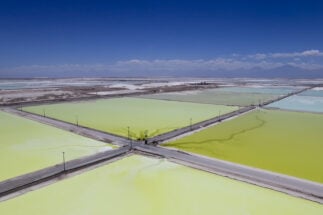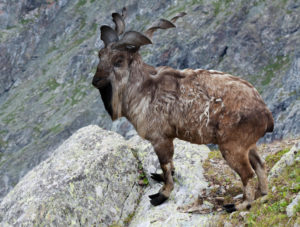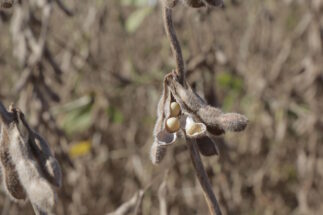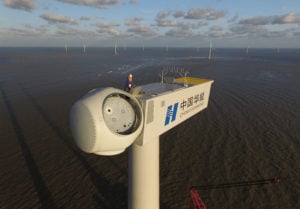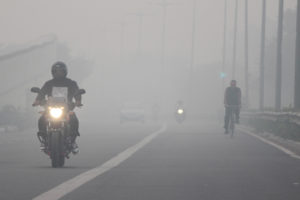Just two countries in the world are carbon-negative: Suriname in South America and Bhutan. But Bhutan, famous for its commitment to conservation, is now considering exploiting its rich forest resources.
The coronavirus pandemic has battered the economy: a report from Bhutan’s central bank says it could shrink by 1.1% this year. Households are already feeling the impact of job losses and wage cuts. The result will be falling standards of living and material welfare, with private consumption expected to drop by 21.8%.
In response, the government may increase timber production. It has said it wants this to be used domestically, reducing imports, and in exported goods. Namgay Tshering, Bhutan’s finance minister, told The Third Pole the government is reassessing some aspects of the economy in light of the Covid-19 situation, and that it aims to reduce imports of wood-based products by 90%. “It’s a low-hanging fruit but we will adopt a sustainable and strategic approach,” the minister said.
Officials from the Department of Forests and Park Services (DoFPS) said they are working on a report setting out the plans, which they will soon submit to the government. The proposals include exporting and making more wood-based products, and supplying charcoal to local industries.
They did not have any estimates on how much timber would be produced, and the number and type of trees that would be felled, as they said they are still considering the challenges involved and cost to the environment. The government’s priority, officials said, is to make timber available in the domestic market to cut imports.
An untapped resource?
Just 5% of Bhutan’s total forest area is used for commercial forest production, according to a World Bank report published in July 2019. The report describes the forestry sector as “underutilised”, with very little timber harvested. It calculated that forests contribute 2% of Bhutan’s total gross domestic product.
Bhutan is recognised globally as a leading country on environmental issues, with its forests protected through strict laws and policies, such as the ban on exports of raw timber. Its development model is framed around conserving the environment. Today, more than 70% of the country is forested, helping Bhutan to absorb three times more carbon from the air than it emits.
Phuntsho Namgyel is a forest analyst who previously worked with the forest department. He told The Third Pole that the forests offer vast economic opportunities. He said, “There is huge scope for Bhutan to increase its timber harvest without leaving permanent damage to the environment. Consequently Bhutan can achieve economic self-reliance, as it will create more employment and economic activities.”
Namgyel said using the country’s forests could bring in more revenue than hydropower – one of Bhutan’s most important sectors.
According to him, the forest can provide up to 100 million truckloads of wood a year. In a presentation last year, he said that they grow by the equivalent of 1.35 million truckloads of wood every year. Yet, he said, the amount of wood removed from the forests is just 0.05 million truckloads, and the country is a net importer of wood. In 2018, it imported wood products worth USD 16.5 million, according to the Massachusetts Institute of Technology’s Observatory of Economic Complexity, which compiles trade data.
Healthy forests, healthy country
The watersheds from the forests provide about 90% of the country’s water, with the remainder coming from glaciers. As a result the forests are critical to hydropower – the biggest revenue generator, bringing in about BTN 12 billion (USD 136 million) every year. Nearly 70% of the population is engaged in economic activities that depend on natural resources, such as agriculture. In addition, the forests and their wildlife are a major tourist attraction.
See: Why are bees dying en masse in Bhutan?
Forests are therefore vital to Bhutan’s economy. But experts differ on the best way to protect them.
“We should cut down some trees to save our forest,” said Namgyel. He said this would actually improve the health of the forests, making them more resilient to fire, pests and diseases.
He explained that as the climate warms, longer dry seasons and falling precipitation mean overcrowded forests are vulnerable to more and bigger forest fires.
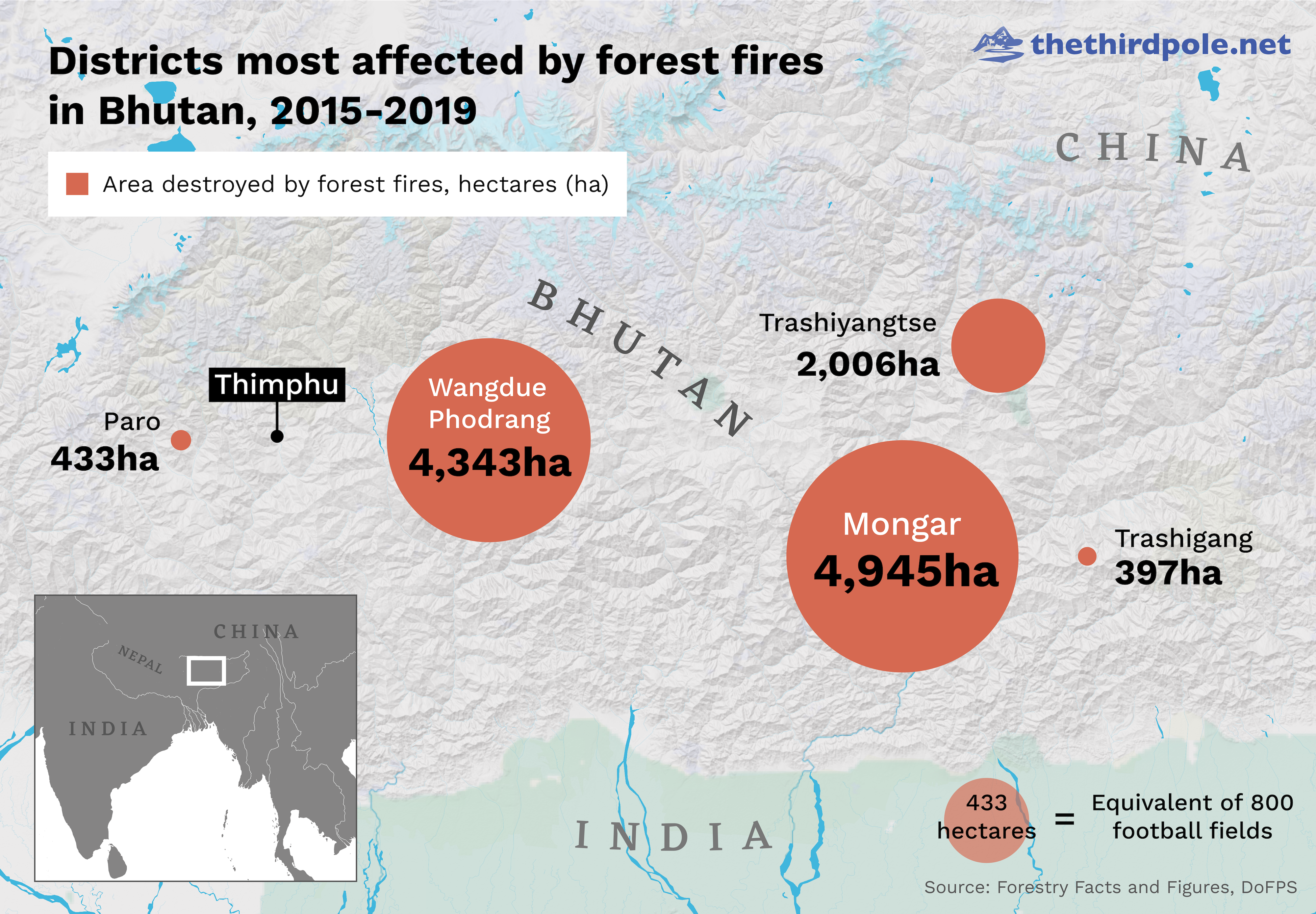
While environmentalists agree that careful thinning and removal of dead undergrowth and prescribed burning would improve the forests’ health and build ecological resilience, they expressed concern that cutting down trees would have far-reaching negative implications on Bhutan’s economy and livelihoods.
Lobsang Dorji, director of the DoFPS, said cutting down trees might present more dangers than benefits. He said it could raise the risk of flooding and subsequent destruction to infrastructure, livelihoods and wildlife. He added that degraded forests take many years to recover, and regeneration can be affected by livestock grazing and the growth of invasive species.
See: Golden langurs killed by people, roads and power lines in Bhutan
Tashi Wangchuk, an independent researcher who previously worked at the DoFPS, said Bhutan does not currently have reliable data on the health of its forests, regeneration rate, and impact of degradation. Adopting western models of forest thinning would not work due to the different nature of the forest as well as geographical terrain, he said.
Climate change is not the only cause of forest degradation in Bhutan, Wangchuk pointed out. Man-made forest fires, illegal logging, livestock grazing and urbanisation also degrade the forests, leading to soil erosion, flooding, landslides and other natural disasters.
Finally, the origins of the pandemic highlight a danger if timber production is ramped up. Nagdrel Lhamo, who leads WWF Bhutan’s forest and wildlife programme, said that disrupting habitats disperses wildlife, leading to conflict with humans and the spread of new diseases. Deforestation and habitat degradation pose risks to human health and well-being, she said.
Lhamo said that policymakers should instead focus on managing existing areas of timber production. She recommended improving harvesting technology and value chains for timber markets rather than expanding to new areas. “Bhutan’s forests are mostly primary old-growth forests and provide valuable ecosystem services such as freshwater for drinking, irrigation and hydropower. If additional areas are cleared for timber extraction it will disrupt the watersheds and water sources, which are already drying up in many places.”
How practical is the plan?
Bhutan’s steep terrain poses a major challenge, rendering much of the forested areas inaccessible. According to the most recent Forest Resources Potential Assessment carried out in 2013, many potential sites lack access to road for transporting the timber. As a result, only 5.8% of land in Bhutan has the potential for commercial timber production.
KB Samal is a retired forest specialist who previously worked at the DoFPS. He said the costs involved, such as building roads and other infrastructure, mean the price of timber will be high and there may not be a market for it. Any plan may therefore not be economically feasible. Further, he said, the 2013 assessment is based on satellite images and does not ascertain actual timber availability and quality.
Samal said extracting timber from remote areas would require substantial upfront investment, and the country might not have access to such finance.
Dorji Wangdi, Bhutan’s newly appointed opposition leader, told The Third Pole that the country’s decisionmakers should be concerned about damage to the ecosystem, such as the permanent loss of plants, insects, birds and other wildlife, resulting from commercialising forest resources. “We should think of what we value more – our forests or economic gains,” he said.
See: Protecting 30% of the earth will bolster economy
But Wangchuk said that officials do not have to choose between forests and the economy, and that trees can be monetised without being cut down. He said officials should consider fiscal incentives for forests via the carbon market.
The Paris Agreement in 2015 set out the Sustainable Development Mechanism, a new system for carbon trading on the global market. It was due to replace the Clean Development Mechanism this year, but is still on hold as negotiations are yet to complete.


